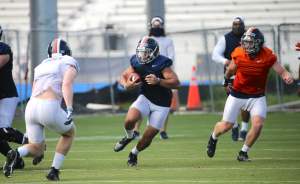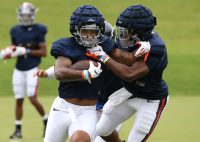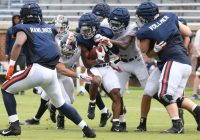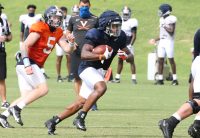Is Taulapapa going to carry the mail for UVA offense, or will it be a 3-headed monster?
By Jerry Ratcliffe
Just before the ACC Championship game in Charlotte last December, I asked Bronco Mendenhall about what it would take for his program to continue to flourish. I asked how much of a priority it would be for 2020 to establish a stronger, more reliable running game.
Mendenhall said then that a more substantial ground attack would be necessary for Virginia to continue to win. So, heading into the 2020 season, exactly where does the running game stand?
Last week, offensive coordinator Robert Anae said that UVA’s ground game should be much improved over last season with the entire offensive line returning in addition to a pair of strong, run-blocking tight ends, and the returning starter at tailback.
Not great, but good, better, Anae stated.
Wayne Taulapapa, who improved as the season progressed in 2019, is back at the starting tailback spot. He’s backed up by Towson transfer Shane Simpson, who was a consensus 2018 All-American in FCS play, and by sophomore Perris Jones, who has played special teams.
UVA is still awaiting word from the NCAA on an appeal for Indiana transfer Ronnie Walker, Jr., from Hopewell, for instant eligibility.
Heading into the Duke game on Saturday, Mendenhall said that Taulapapa would start, but didn’t rule out using his other two backs.
“Based on Wayne’s production and effectiveness, the results will determine how much Shane and Perris play,” the head coach said. “There isn’t much difference between the three. They’ve all had their days, they’ve all had their moments and they’ve all had their productivity. They’re all very similar in yield, but different in style, so I really won’t know, just to be honest, until we play a game if Wayne is the only back or if we’re using multiple backs, or how that plays out.”
All three players are somewhat similar in size. Taulapapa is 5-foot-9, 210 pounds, while Simpson is 5-11, 200, and Jones is a tad smaller at 5-8, 175.
Taulapapa netted 473 yards rushing on 116 attempts last season — a 4.1 yards per carry average — along with 12 touchdowns.
Simpson, who missed most of last season due to a severe knee injury, compiled 711 yards rushing on 151 attempts (4.7 per carry) and six TDs in 2018. He was also a threat as a kick returner.
Meanwhile, Jones hasn’t carried the ball at Virginia, but has potential.
Styles, Bronco said? What are the styles?
“With Wayne, you get consistent, steady, slashing and positive yardage,” Mendenhall said. “With Shane, what you get is vision and experience and a unique knack to find the hole wherever it is, and with more patience, so I really like his vision.
“With Perris, you get escapability and the ability to create where he can make things out of space where it doesn’t appear [the defense] has been blocked effectively, or there isn’t much space and all of a sudden there’s positive yards, and so a little bit more ability to make you miss in the open field.”
So, consistency with Taulapapa, vision and patience with Simpson, and creativity with Jones. Put all that together and you have an NFL back.
Mendenhall said that if Taulapapa is successful, then “he’ll just keep going.” Bronco’s philosophy is to give one running back the bulk of the carries, if not all of the carries. If one guy isn’t getting the job done, then that opens the door for others.
That means, Simpson and Jones are waiting in the wings.
“If [Taulapapa] isn’t successful, then you’ll most likely see Shane, and if he’s not, then you most likely will see Perris. But again, you might see Perris next based on the style that the defense plays. It might be more conducive to the way that he runs.”
Mendenhall said the coaching staff is happy if Taulapapa is carrying the ball effectively for positive yards. If that happens, “he might be the only one that you see,” Mendenhall said.
If there’s a stall, fans could see either Simpson or Jones pretty quickly.
After two games and two losses, Duke’s defense is giving up 131 yards per game on the ground and an average of 3.1 yards per carry to opponents, who have rushed the ball 84 times against the Blue Devils (and scored three rushing TDs).
Virginia, which has won five straight games against the Blue Devils, rushed for 154 yards and five scores last season against Duke. Taulapapa had 77 of those yards on 14 attempts, while Bryce Perkins had 22 carries for 62 yards.












